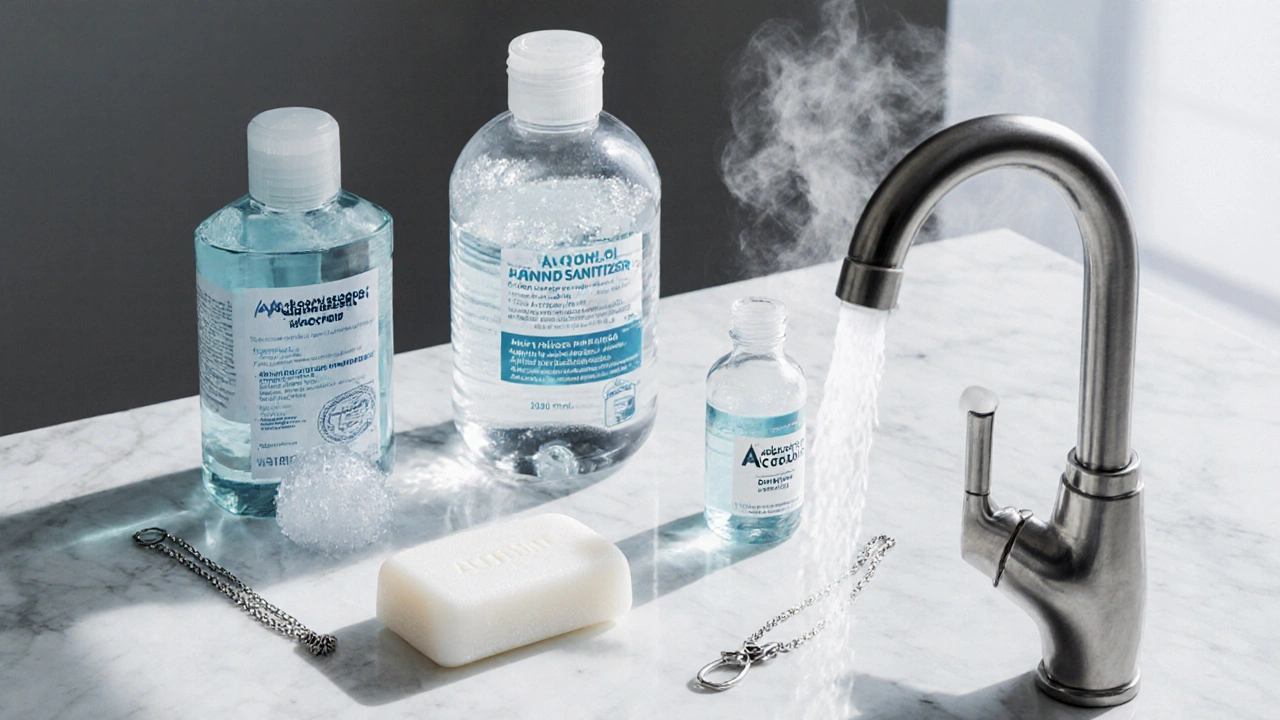Irritant Contact Dermatitis Symptom Checker
Check Your Symptoms
Answer the following questions to assess if your skin reaction could be irritant contact dermatitis.
Your Results
irritant contact dermatitis is a common skin problem that most people encounter at some point, whether from a harsh soap or a workplace chemical. It isn’t an allergy - it’s the skin’s direct reaction to something that strips away its protective barrier.
Key Takeaways
- Irritant contact dermatitis (ICD) occurs when substances damage the skin’s outer layer.
- Common triggers include detergents, metals, and even frequent hand sanitizer use.
- Treatment focuses on soothing the skin, repairing the barrier, and avoiding the irritant.
- If symptoms spread, blister, or don’t improve within a week, see a healthcare professional.
- Long‑term management often involves lifestyle tweaks and protective gear.
What Is Irritant Contact Dermatitis?
When your skin reacts to everyday substances, Irritant Contact Dermatitis is a non‑allergic inflammation caused by direct damage to the skin’s protective barrier from chemicals, detergents, or physical agents. Unlike an allergic response, ICD does not require prior sensitisation - the irritant can cause a reaction the first time it touches your skin.
How It Differs From Allergic Contact Dermatitis
Both conditions affect the skin, but they arise from distinct mechanisms. The table below highlights the main differences.
| Feature | Irritant Contact Dermatitis | Allergic Contact Dermatitis |
|---|---|---|
| Cause | Direct chemical or physical damage | Immune‑mediated reaction to an allergen |
| Onset | Immediate to hours after exposure | Requires prior sensitisation; appears 24‑48hrs after re‑exposure |
| Typical Triggers | Detergents, solvents, metals, alcohol‑based sanitizers | Nickel, fragrance mix, latex, certain preservatives |
| Skin Appearance | Redness, swelling, dry‑patches, sometimes fissures | Itchy papules, vesicles, sometimes spreading rash |
| Diagnosis | Clinical history + visual exam | Patch testing confirms allergen |

Common Causes and Everyday Culprits
Identify what’s likely behind the irritation before you can effectively treat it.
- Sodium Lauryl Sulfate is a foaming agent found in many shampoos and cleansers that can strip natural oils.
- Nickel is a metal present in jewelry, belt buckles, and some clothing fasteners.
- Hand Sanitizer (especially high‑percentage alcohol versions) can dry out the skin after repeated use.
- Industrial solvents like acetone (used in nail polish remover) aggressively dissolve lipids.
- Frequent exposure to water, especially hot water, weakens the skin barrier.
The Physiology Behind the Rash
The skin barrier, mainly the stratum corneum, acts like a brick wall: corneocytes (the bricks) are glued together by lipids (the mortar). When an irritant disrupts these lipids, water loss increases, and inflammatory mediators flood the area.
Key players include:
- Histamine released from mast cells contributes to redness and swelling.
- Pro‑inflammatory cytokines such as IL‑1α and TNF‑α amplify the response.
Recognising Symptoms
Typical signs appear within minutes to a few hours after contact:
- Red, inflamed patches that may feel warm.
- Dry, flaky skin or small cracks (fissures) in severe cases.
- Occasional itching or burning sensation.
If you notice blisters, spreading rash, or the problem persists beyond a week, it’s time to get medical advice.
Effective Treatment Options
Treatment aims to reduce inflammation, restore the barrier, and keep the irritant away.
- Topical Steroids (e.g., hydrocortisone 1% cream) calm redness and swelling when used for a few days.
- Emollients such as petrolatum‑based ointments lock in moisture and rebuild the lipid layer.
- Cool compresses for 10-15minutes can soothe burning.
- Over‑the‑counter antihistamine tablets may help if itching is prominent.
For stubborn cases, a dermatologist might prescribe a stronger steroid or recommend phototherapy.

Preventive Measures and Lifestyle Tweaks
Stopping the problem before it starts saves time and discomfort.
- Wear gloves when handling detergents, solvents, or metal parts. Choose cotton‑lined nitrile gloves for comfort.
- Apply a fragrance‑free emollient after hand‑washing, especially if you use hot water.
- Switch to mild, sulfate‑free cleansers; look for “cocamidopropyl betaine” as a gentler alternative.
- If you suspect a metal allergy, opt for hypoallergenic jewelry (stainless steel or titanium).
- Limit the use of alcohol‑based sanitizers; keep a hand‑cream nearby to re‑hydrate.
Managing Chronic or Occupational Cases
People in certain jobs-healthcare, cleaning, hairdressing-face repeated exposure. Long‑term strategies include:
- Rotating tasks to reduce daily skin load.
- Implementing barrier‑enhancing creams during the workday.
- Regular skin checks by an occupational health professional.
- Documenting exposures to help pinpoint the most harmful agent.
Quick Checklist for Everyday Use
- Identify and label known irritants in your home or workplace.
- Keep a travel‑size barrier cream in your bag.
- Replace harsh soaps with gentle, pH‑balanced options.
- Use protective gloves whenever chemicals are involved.
- Seek medical advice if the rash worsens or lasts more than 7days.
Frequently Asked Questions
Can irritant contact dermatitis become allergic over time?
Repeated exposure can weaken the skin barrier, making it easier for an allergen to penetrate and trigger an allergic response, but the two conditions remain distinct.
Is over‑the‑counter hydrocortisone safe for everyone?
For short‑term use on small areas it’s generally safe, but people with diabetes, thin skin, or who are pregnant should consult a doctor first.
Why does my hand feel dry after using sanitizer?
Alcohol strips the natural lipids that keep skin supple, leading to rapid water loss and a feeling of dryness.
Can I test which product is irritating me at home?
A simple patch test works: apply a tiny amount of the product to a small forearm area, cover it, and wait 24hours. If redness appears, avoid that product.
When should I see a dermatologist?
If the rash spreads, develops blisters, does not improve after 7days of self‑care, or you notice signs of infection such as pus or fever, schedule an appointment.


10 Comments
Chelsea Kerr
October 9, 2025 AT 20:56Thanks for laying out the basics so clearly 😊. It’s easy to dismiss a red patch as just “dry skin,” but the barrier breakdown is a real biochemical battle. Remember to keep a fragrance‑free moisturizer handy after each wash – it’s like a shield for your stratum corneum.
And if you notice blisters or the rash lingers past a week, don’t wait – see a dermatologist sooner rather than later. Stay gentle with your skin, and your skin will thank you! 🙌
Tom Becker
October 14, 2025 AT 14:56Yo i swear the big corp usin chemicals in soaps dont want u to know how they r killin our skin 😱 they hide it behind fancy labels and shiny ads. Every time i wash my hands i feel like i’m signing a pact with the devil. It’s not just a rash, it’s a conspiracy against our bodies! And those sanitizers? pure poison, they’re stealing our moisture like thieves in the night! Wake up, people!!!
Laura Sanders
October 19, 2025 AT 08:56One must recognize the epidermal barrier as a sophisticated lipid matrix that functions as a dynamic shield against exogenous insults. Its disruption precipitates an inflammatory cascade that manifests as erythema and scaling. Proper emollient therapy restores the lamellar architecture and aborts the pathogenic feedback loop.
Jai Patel
October 24, 2025 AT 02:56Hey Tom, I hear the frustration, but let’s channel that energy into practical steps. First, swap those harsh soaps for a sulfate‑free, pH‑balanced cleanser – it’s like giving your skin a gentle hug. Second, keep a lightweight, fragrance‑free barrier cream in your pocket; a quick dab after washing locks in moisture and patches up micro‑tears.
Third, consider wearing nitrile gloves when handling chemicals – they’re the unsung heroes of occupational skin health.
If you notice persistent redness after a week of these tweaks, a short course of low‑potency hydrocortisone can calm the inflammation. Stay proactive, and you’ll turn that drama into a victory for your skin!
Zara @WSLab
October 28, 2025 AT 20:56Great tips! 🌟 I’ll definitely try the gentle cleanser and keep a cream handy. Thanks for the boost! 🙏
Randy Pierson
November 2, 2025 AT 14:56Your skin is the first line of defense, so treating it with respect is non‑negotiable. Opt for products that list “water” and “glycerin” among the first three ingredients – they act as humectants that draw water into the stratum corneum. Avoid fragrances, which are notorious irritants that can provoke a cytokine surge. When in doubt, a patch test on a small forearm area for 24 hours can save you a lot of discomfort later.
Bruce T
November 7, 2025 AT 08:56If you keep ignoring the irritation, you're just asking for trouble.
Darla Sudheer
November 12, 2025 AT 02:56Totally agree – a little care now prevents a big problem later.
Elizabeth González
November 16, 2025 AT 20:56The skin, as a living organ, mirrors the balance between external forces and internal resilience. When irritants assault the delicate lipid matrix, the ensuing inflammation is a manifestation of the body's attempt to re‑establish equilibrium. Therefore, therapeutic interventions must aim not only to soothe the symptoms but also to reinforce the barrier, thereby restoring homeostasis. Continual vigilance and mindful product selection become indispensable practices in this restorative journey.
chioma uche
November 21, 2025 AT 14:56Our nation’s people deserve protection from these foreign chemicals trying to weaken our bodies. It’s an insult to our heritage that they push such harmful products on us. We must demand stricter regulations and ban these irritants now!